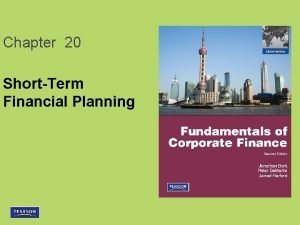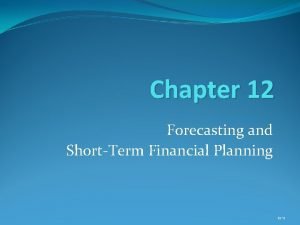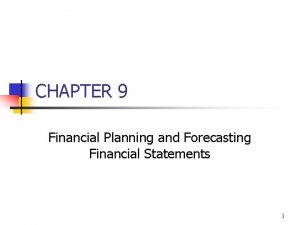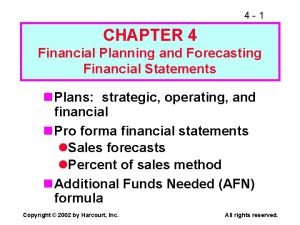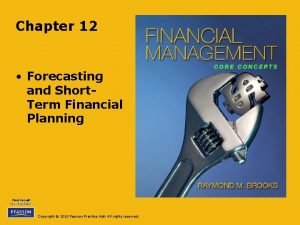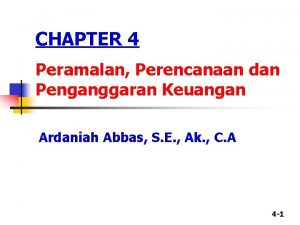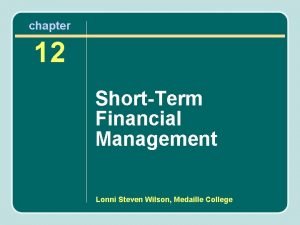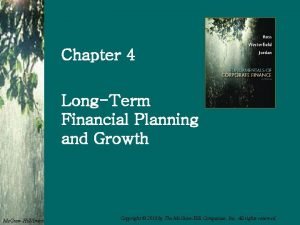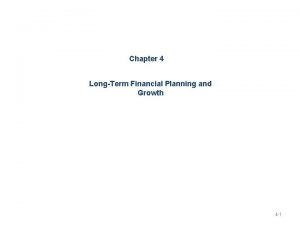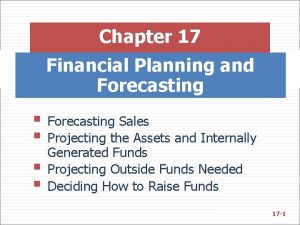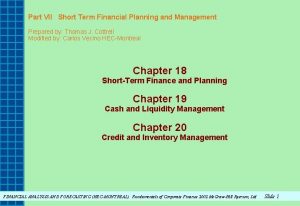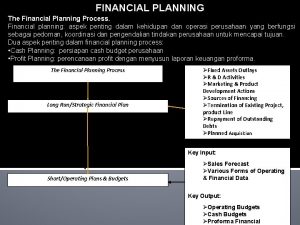FINANCIAL MANAGEMENT Forecasting and short term financial planning

















- Slides: 17

FINANCIAL MANAGEMENT Forecasting and short term financial planning

Introduction • Is the future uncertain ? Yes! • Can we plan for it? Yes! • Forecasting the coming period = draw a financial picture of the firm for the next week, quarter, year; • Major task in FM, starting point for the firm’s shortterm financial action plan; • Tools used in forecasting: – Cash forecasts (cash budgets); – Pro forma financial statements (cash budget projections);

Introduction • Financial forecasts usually begin with sales estimates. • Deviations from the plan are likely; • How do the managers solve cash shortages? • What to do in the case in which the company experiences excess in cash? Is it a good thing? • How to forecast the timing of cash flow into and out of the company in the first place?

Introduction • Short-term vs. long-term financial decisions: – Length of effect; – Cost; – Degree of information gathering prior to the decision;

Sources and uses of cash • Goal of cash management: – Hold sufficient cash on hand (but not to much) to meet business obligations in a timely and appropriate manner. • Cash budget is an analytical tool that: – estimates the future timing of cash inflows and cash outflows and projects potential shortfalls and surpluses. • Usually begins with cash receipts (sales forecasting); • Remember the difference between: – Sales revenue and the receipt of cash from sales; – Cost of goods sold and the timing of the cash outflow for the production goods.

Cash budget: a basic example

Examples of cash inflows • Cash sales from products and services; • Accounts receivables (mainly credit sales); • Cash sales of equipment or other assets; • Funding sources (bank loans, bond sales, stock sales).

Examples of cash outflows • • • Cash purchases (supplies, inventories, raw materials); Accounts payable (to suppliers); Wages/salaries; Rent, lease, or mortgage payments; Utility payments (i. e. , overhead); Shipping costs; Interest payments; Dividend payments; Paying off debt (loans and bonds); Repurchase of stock.

Cash budgeting and the sales forecast • The timing of the sale and the cash inflow from the sale often happen at different times; – A. When will the sales occur? (Marketing, financial depts. ) – B. When will the firm receive the money for the sales? (Financial dept. , cash vs. credit sales)

Sales forecast • Next ? • (1) average of the two previous growth rates: 22% => sales in 2007 of 50, 654, 000 $; • (2) only the prior year’s growth rate: 18% => sales in 2007 of 48, 413, 000 $; • (3) average dollar increase in sales: 6, 800, 000 $ => sales in 2007 of 47, 828, 000 $.

Sales forecast • The actual sales revenues amount in 2007: • We need more sophisticated model than just historical data to project sales for a reliable number; • We need: Internal data + External data; • Analysis of the Bridge Water Pumps and Filters example, pg. 355 -357;

Cash outflows from production • Sales forecasts are used for scheduling production; • Cash expenditures are thus closely tied to sales; • Cash outflows timing: – Raw materials: before the production; – Wages/salaries: in the same period with production; – Overheads: some time after the beginning of production; – Shipping costs: after the sale of the production. • ! The recording of the cost of goods sold occurs at the time of the sale but the cash flow may take place over an extended time period. [Analysis of Example 12. 1]

The cash forecast: deficits and surpluses • Goal: hold sufficient cash to pay bills without carrying excess cash (i. e. , lost earning power for the firm); • Main categories of cash outflows: – A. Accounts payable for materials and supplies; – B. Salaries, labor wages, taxes, and other operating expenses; – C. Capital expenditures; – D. Long-term financing expenses (interest, dividends, issuing cost of debt and equity). • Usually, the first two categories apply to the daily operating decisions of the firm.

The cash forecast • This monthly cash flow estimate allows to anticipate periods with deficits and surpluses. • Need to borrow in March/April but in June the desired level of cash reserves will be available (15, 000 $).

Funding cash deficits • Solutions for cash shortfalls: – Cash from savings (i. e. , the simplest way to cover deficits) – Unsecured loans (lines of credit) – Secured loans (with accounts receivable or inventories); – Other sources (commercial paper, trade credit) • Line of credit: prearranged loan with no specific assets backing the loan in case of default; – Clean-up period: keep a zero balance for a certain period; – The interest rate floats (market rates, e. g. , ROBOR 3 M). • Commercial paper: financial asset sold to investors like bonds or stocks but with shorter maturity (< 90 days, max. 270).

Funding cash deficits/Investing cash surpluses • Delaying the suppliers is an option but it also has the drawback of “tainting” an immaculate client behavior. • Options for cash excess: – Savings account, marketable securities; – Repay lenders and owners (retire debt early or pay extra dividends); – Replace aging assets; – Invest in the company, accepting +NPV projects.

Planning with pro forma financial statements
 Long and short
Long and short Long medium and short term planning in primary schools
Long medium and short term planning in primary schools Short term and long term cash forecasting
Short term and long term cash forecasting Short term human resources examples
Short term human resources examples What is short term financial planning
What is short term financial planning Short term financial planning
Short term financial planning Financial planning and forecasting
Financial planning and forecasting Financial planning and forecasting
Financial planning and forecasting Financial planning and forecasting problems with solutions
Financial planning and forecasting problems with solutions Financial analysis planning and forecasting
Financial analysis planning and forecasting Makalah peramalan perencanaan dan penganggaran keuangan
Makalah peramalan perencanaan dan penganggaran keuangan Short term financial management
Short term financial management Difference between long term and short term liabilities
Difference between long term and short term liabilities Difference between long term and short term liabilities
Difference between long term and short term liabilities Example of long term plans
Example of long term plans Long term memory vs short term memory
Long term memory vs short term memory Long term financial planning and growth chapter 4
Long term financial planning and growth chapter 4 Long term financial planning and growth chapter 4
Long term financial planning and growth chapter 4




